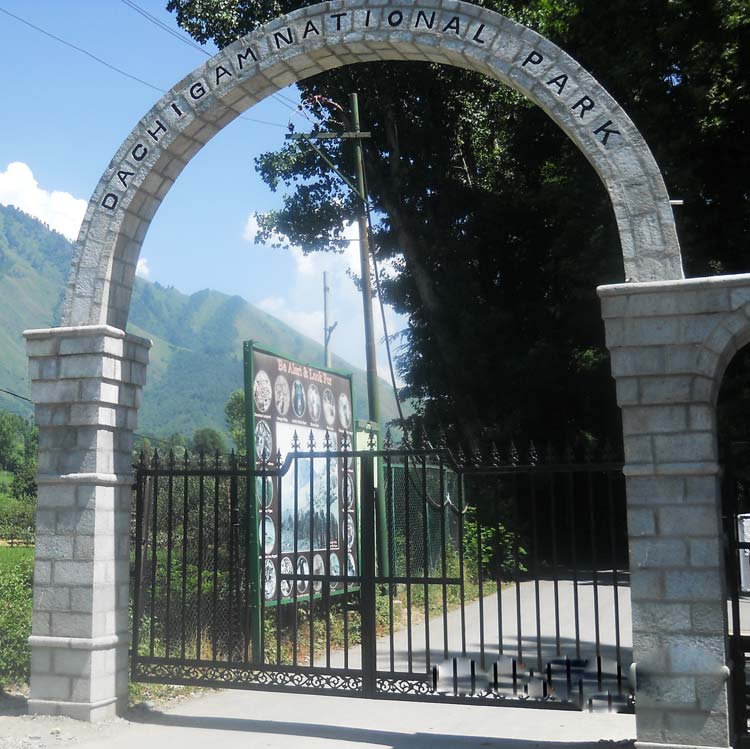by Hirra Azmat
A decrease in forest cover of the park can lead to more silt in the water which will eventually flow into Dal Lake and cause ecological disruptions.
The Dachigam National Park in Kashmir, surrounded by the lush Zabarwan mountains, stands out with its unique and diverse landscape. The protected area is an important conservation reserve serving as a habitat for some endemic and endangered species in the valley. However, the park is now at risk from the increasing urbanisation in its vicinity. A new study has revealed that the built-up areas have expanded by 325 per cent near the park over the last 55 years, resulting in habitat degradation and loss. The research also predicted a 10 percent increase in urban development in the future along with a decline in forests, shrublands and pastures.
The study was published in the Environmental Monitoring and Assessment, a journal published by Springer, in September 2023. It aimed to look at changes in land use and land cover within and around Dachigam National Park over the past 55 years (1965–2020) and forecast future changes up to 2100. The study was conducted using remote sensing and Geographic Information Systems (GIS) technology, aided by landscape models.
Mounting Anthropogenic Pressures
The Kashmir Himalaya in India is an important part of the global biodiversity hotspot network which comprises 36 such regions. These hotspots are known for harbouring rich biodiversity within relatively small geographical areas. In these zones, protected areas serve as a haven for biodiversity conservation and help in maintaining ecological balance.
Situated about 20 kilometres from the main city of Srinagar, the Dachigam National Park is one of the most important protected areas in Kashmir Himalaya. It is not just home to the critically endangered hangul (Kashmir stag), but also a habitat for several other species such as Asiatic black bears, leopards, langurs, rare medicinal plants and a variety of endemic bird species. Additionally, the park has an abundant forest cover including conifers and oak trees besides shrublands and meadows.
Irfan Rashid, Assistant Professor at the Department of Geoinformatics, University of Kashmir said that this conservation reserve plays a crucial role in supporting Dal Lake, the second largest lake in Jammu and Kashmir. “The water from Dachigam National Park flows into Dal Lake making it an important catchment area and source of water for Srinagar city. The catchment area of Dal Lake covers around 337 square kilometres, with Dachigam National Park occupying about 141 square kilometres.”
However, this crucial protected area is currently under significant threat, as highlighted by recent research. “Our study aimed to investigate whether Dachigam had any buffering effect on the surrounding area,” Rashid, who is also a corresponding author of the study, said. “The findings showed that the built-up areas in the vicinity of the park have increased by 325 per cent in the last six decades. In the same period, the surface aquatic vegetation in Dal Lake increased by about 175 per cent. This increase was due to the growth of built-up areas, which probably led to more sewage entering the lake. Sewage contains nutrients. Besides temperature, nutrients play an important role in the growth of aquatic vegetation.” The findings revealed that inside the park, the forest cover decreased by seven per cent, and there was a notable reduction in natural habitat both within (39 per cent) and outside (30 per cent) of the park, indicating habitat fragmentation. The research also predicted a 10 per cent increase in urban development in the future that could induce the degradation of forests, shrublands, and pastures.
Experts say they believe that the significant changes in and around Dachigam National Park have a huge influence on Dal Lake. “A decrease in forest cover of the park can lead to more silt in the water which will eventually flow into Dal Lake and cause ecological disruptions. There is a dire need for more sewage treatment plants in the catchment area or to develop an efficient mechanism which will stop the intrusion of nutrients contained within the sewage into the lake,” says Rashid.
Rashid pointed out that land system changes can also raise the frequency of human-wildlife conflicts in the surrounding areas. “For example, bears have been found in residential areas of Srinagar city like Rajbagh and Sonwar. As more people venture into these pristine areas, conflicts between humans and animals become more common.”
Threats to Protected Areas
The other protected areas of Kashmir Himalaya are equally bearing the brunt of anthropogenic pressures. An example is the case of Gulmarg Wildlife Sanctuary in North Kashmir. A recent study published in Nordic Journal of Botany evaluated the floristic elements of Gulmarg Wildlife Sanctuary (GWLS), Kashmir Himalaya.
During the study, 364 species of plant species were recorded from the sanctuary. Out of these plant species, 161 species are native to the Himalayan region and the remaining 203 species are non-natives. Out of the total 161 native plant species, 82 were endemic to the Himalayan region. Further, 22 plant species are threatened.
The findings stated that the major threats to biodiversity within the sanctuary include “over-exploitation, overgrazing, invasive species, human settlements, huge tourism influx and pollution”.
Gautam Talukdar, a scientist at the Wildlife Institute of India (WII) told Mongabay India that the Himalayan ecosystems are becoming increasingly fragile due to the escalating anthropogenic pressures and climate change.
“Protected areas are facing land-use change in terms of shifts of agricultural practices, and rampant deforestation for settlements due to population growth,” he said. “Indigenous practices, such as hunting, are becoming unsustainable. Overexploitation of resources due to the high dependence of population on forest products leads to loss of habitats over the years, which is pushing animals towards range shifts and potential displacement.”
The impact of human activities in the protected areas is exacerbated by irregular weather patterns and extreme weather events. Moreover, the rampant and unplanned infrastructure development without a scientifically informed plan is making the conservation reserves even more vulnerable to the effects of climate change observed in the Indian Himalayan region, according to the experts Mongabay India spoke to.
A recent example can be drawn from Himachal Pradesh; heavy rains in 2023 caused flash floods and landslides in the Kullu-Manali-Shimla region, affecting the Great Himalayan National Park. Similarly, Uttarakhand has experienced multiple calamities in recent years 2022-2023, with the 2013 Uttarakhand floods being one of the most devastating. “Likewise, Sikkim recently witnessed flash floods and landslides due to intense rainfall. Protected areas such as the Khangchendzonga Biosphere Reserve are also under imminent threat, with landslides blocking roads and disrupting access,” Talukdar added.
The scientists noted that rising temperatures can cause shifts in vegetation zones, impacting the habitats of various wildlife species. Talukdar said that the snow leopard, an iconic species in the Himalayas, is facing competition with other sympatries such as the common leopard in terms of prey species range shift concerning elevations. “This disrupts the balance in protected areas. Also, climate change drives shifts in animal habitats and behaviour, thus human-wildlife conflicts are on the rise. In protected areas, this can lead to threats to both wildlife and human safety,” he added.
The spread of alien animal and plant species or invasive species is another key threat to these ecologically fragile areas in the Indian Himalayan Region. “Take the case of the Great Himalayan National Park in Himachal Pradesh which is currently grappling with the exotic brown trout invasion,” Talukdar said. “This is leading to a phenology shift of Himalayan native fish species (Snow Trout). Phenology is the study of seasonal or periodic cycles in ecosystems. It is, essentially, ‘nature’s calendar’. For fish, phenology is often linked to the timing of important life events such as spawning, migrations, and hatching. Studies have shown that the range shifts in aquatic species and phenology change in breeding are because of both invasive species and human activities indicating the fragility of Himalayan waters.”
The unsustainable tourism sector is considered another significant threat to these protected areas. Anzar Khuroo, Associate Professor, Department of Botany, University of Kashmir, said, “While the government needs to promote developing ventures and create new employment opportunities, the concept of sustainable tourism should be pursued properly. Improperly implemented ‘eco-tourism’ can put further anthropogenic pressure on protected areas since they are the primary attraction for a large number of tourists.”
Key Priorities
The scientists emphasised that attention must be given to assessing the quantum of anthropogenic threats prevailing in and around the protected areas. Only when the status of protected landscapes is known can further steps be taken to protect and conserve them.

Principal Scientist at the CSIR – Institute of Himalayan Bioresource Technology (IHBT), Palampur, Himachal Pradesh, Amit Chawla said that for the effective management of protected areas, it is essential to implement the schemes and scientific management plans, along with ensuring that adequate funding goes into these schemes.
“There is usually insufficient staff strength for management of protected areas,” he said. “As most of the protected areas in the Indian Himalayan Region are situated in the high-altitude zone with arduous terrains, the field staff is to be trained properly and should be provided patrolling and camping gear and advanced field equipment for regular monitoring,” he said.
Quoting his recent study, Chawla emphasised that the protected area network is strategically important for considering any restoring efforts of threatened plants. In their research, they suggested a rewilding plan for Dactylorhiza hatagirea, a highly threatened orchid, endemic to the Himalayas.
The experts emphasised that any conservation effort would be incomplete without the involvement of the local communities. These communities often have a deep understanding of their environment which can be invaluable for conservation efforts.
“There is a need for strengthening the existing educational institutes in the vicinity with science and socio-economics-based teaching programmes,” Chawla said. “This would help provide the right education and impart the right skills so that the local youth are trained and take up conservation efforts by formation of self-help groups or NGOs.”

He added that the popularization of technologies can be adopted to promote value addition of the farm produce, introduction of alternative high-value crops such as floriculture, training for medicinal plants cultivation etc., which can enhance the existing income of local communities and possibly reduce pressure of dependencies on protected areas for livelihood.
The experts stressed the need to prioritise and develop climate change adaptation plans for Himalayan protected areas, including monitoring and mitigation strategies.
“It is essential to recognise that long-term protection and conservation of the Himalayan protected areas require a multi-stakeholder approach, involving governments, local communities, NGOs, and the international community,” Talukdar said.
(The report was first published on the Mongabay website and is reproduced under Creative Commons Attribution-No Derivatives 4.0 International License.)














